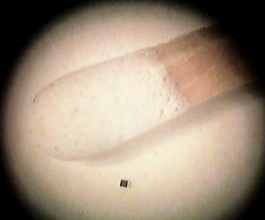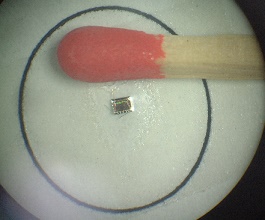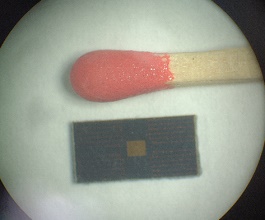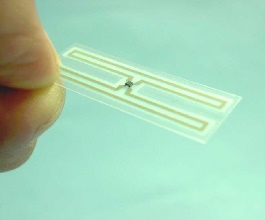Our Design Passive RFID Chip

A passive RFID tag that does not contain a battery. The operating power for an RFID tag is supplied by an RFID reader. When radio waves from an RFID reader are encountered by a passive RFID tag, the antenna connected a rectifier in an RFID tag generates operating power for an RFID tag by itself. An RFID tag, then sends the information encoded in the tag's memory.
Our company AMPLET, Inc. (later known as the AMPLET Communication Laboratory) developed the UHF(900MHz) and 2.45GHz Dualband Reflection-type passive RFID in collaboration with Telemedic in 2003.
The Very Small RFID Chip with Antenna

* RFID chip with an internal very small antenna
* 1mm communication range with a 2.45GHz RFID reader (10mW RF output)
According to the experimental results of antenna, which mounted on the RFID IC chip, with Professor Dr. Jong Myung Woo (a researcher of small antennas) of CNU (Chungnam National University), we found that the performance (antenna gain) of a very small antenna mounted on the IC chip reduces linearly up to the Electrical Length of the antenna of 1/60 wavelength. But the size of antenna less than 1/60 wavelength, the antenna performance goes from bad to worse. Therefore, we determine that the chip size of the RFID IC at 2.45GHz is 1.2mm square at least.
The Small RFID for Practical Use

* RFID chip with an external small antenna
* 50mm communication range with a 2.45GHz RFID reader (10mW RF output)
Our customers asked us a small RFID tag with 30mm communication range for using to identify a person, which can paste with glue on a nail. They planned to use a 2.45GHz RFID reader (10mW RF output) with a simple dipole antenna or a small loop antenna.
We designed some kinds of 5mm × 8mm size antennas for this purpose, and made prototype RFID tags, The result of this development, we could realize the communication distance of 50mm.
The RFID for Long Range Communication

* RFID Chip with an external dual dipole antenna
* 500mm communication range with a 2.45GHz RFID reader (200mW RF output)
We thought that a practical RFID system would require a communication range of 500mm at least, when we use a 2.45GHz RFID reader (200mW RF Output).
We developed our original RFID tag, which has two separated antennas. One antenna is used for communication, and other antenna uses for regenerating operation power for an RFID tag.
Compared to an usual one-antenna type RFID tag, our two-antenna type RFID tag could achieve the communication range 30% longer.




